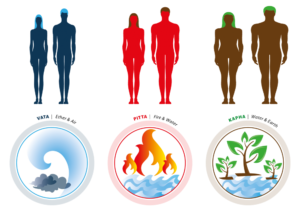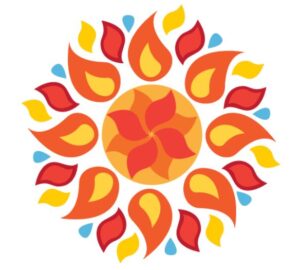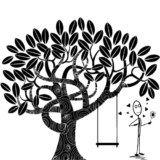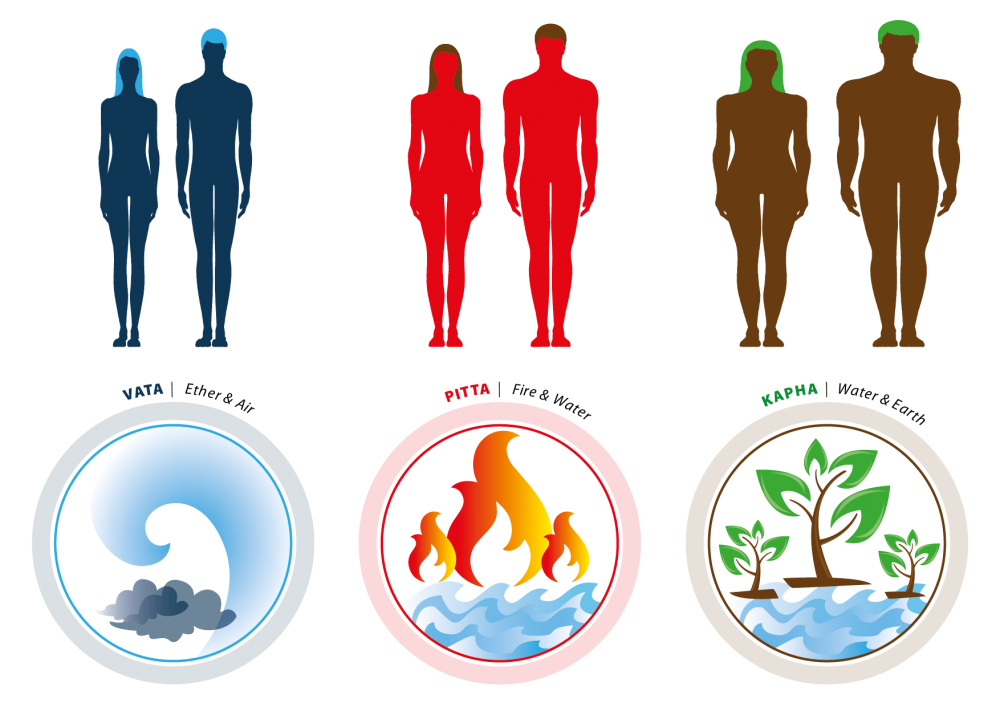Ayurveda, which derives from ancient Vedic scriptures, is a 5,000 year-old medical ideology and philosophy based on the idea that we are all made up of different types of energy.
There are three Doshas in Ayurveda that describe the dominant state of mind/body: Vata, Pitta, and Kapha. While all three are present in everyone, Ayurveda suggests that we each have a dominant Dosha that is unwavering from birth, and ideally an equal (though often fluctuating) balance between the other two. If Doshas are balanced, we are healthy; when they are unbalanced, we develop a disorder commonly expressed by skin problems, impaired nutrition, insomnia, irritability, and anxiety.
Vata, Pitta, and Kapha are all important to our biology in some way, so no one is greater than, or superior to, any other. Each has a very specific set of basic functions to perform in the body.
That said, when the Doshas are out of control, our wellbeing can be damaged. However, before we get into the particulars of each of the three Doshas, it is helpful to understand their basic nature and their wider function in the natural world.
Throughout Ayurveda, the most basic building blocks in the material world are the five elements: space, air, fire, water, and earth.
Vata is characterized by the mobile nature of Air (Wind) energy.
Pitta embodies the transformative nature of Fire energy.
And Kapha reflects the binding nature of Water energy.

To Ayurveda, Pitta is one of the three Doshas—energetic forces of nature that make up the universe and everything within it, including us! Pitta is associated with the components of fire and water, but the former is more prominent. Together, they are the powerful power that controls the transformational processes of the body; metabolism and even the hormones of the body are believed to be regulated by Pitta.
Pitta is the hottest, oiliest, and sharpest of the three Doshas of Ayurveda. When you feel overheated in any way, there may be an abundance of the Pitta Dosha inside your body.
What’s The Meaning of Pitta?

According to Ayurveda, Pittas are willing, strong, dominant, creative, driven, and definitive. If Pitta is out of control, they can become irritable, furious, judgmental, hostile, and even violent. They may have an acidic stomach, oversensitive skin, extreme body pain, or heartburn.
In order to recover Pitta’s equilibrium, it is advised to eat foods that neutralize Pitta’s warm qualities. Out of control Pitta should resist spicy foods and heating vegetables such as garlic, onions or chili peppers. It is also advised that Yoga Asanas be performed to keep it in check.
Transformation is the primary function of Pitta. The Pitta Dosha governs all the different forms of digestion and transformation that manifests in our mind and body—from digesting sensory impressions and emotional reactions to transforming Chyle (lymph and fatty matter from partially digested food) into protoplasmic substances such as sperm and ova, and how we discriminate between right and wrong.
Pitta is closely linked to Agni (Digestive Fire). The properties are pungent, hot, penetrating, greasy, oily, sticky, liquid, spreading, and sour. The primary locus of Pitta is the small intestine where most chemical degradation happens, but it also exists in the eyes, blood, sweat glands, stomach, and lymph.
Made up of Agni (Fire) and Jala (Water), Pitta seems to be a contradiction in terms, but its two constituents are actually complementary. The liquid nature of Pitta protects the tissues from the destructive aspects of fire and enables Pitta’s metabolic properties to flow through the body in fluids such as bile, digestive enzymes, and hormones.
In addition to playing an important role in the digestive and endocrine processes, Pitta influences body temperature, visual perception, appetite, thirst, and the quality of the skin.
Symptoms of Pitta Dosha Imbalance:
Physical:
• Heightened hunger and/or thirst
• Urinary tract irritation
• Early hair loss or grey hair, greasy hair, excessive body hair growth
• Hormonal deficiency
• Giddiness and headaches/migraines
• Hot bursts and demand for things that have a cooling impact on the body
• Foul breath/body odor
• Bloated swelling, acne, cold sore throat
• Sickness when skipping meals
• Nausea
• Tenderness in breasts/testicles
• Discoloration of the skin
• Burning feelings in the body
• Sensitivity to the sun and heat
Behavioral:
• Impatience
• Irritation
• Excessive Ego
• An intense sensation of heat in the body
• Agitation, rage, irritability
• Judgment, impatience, disapproval, intolerance
• Extreme perfectionist tendencies
• Overly targeted/result-oriented
• Dissatisfaction
• Envy
Do You Need To Balance Pitta?
Ask these questions to see if you have to manage Pitta:
1. Do you notice some pain in the hot weather?
2. Are you a perfectionist, or look for perfection in your stuffs?
3. Do you get hot flashes?
4. Is your skin gritty and sensitive to rashes and rashes?
5. Are you always frustrated or impatient?
6. Do you have an abundance of stomach acid?
7. Are you having loose bowel movements?
If you answered yes to most of these questions, you have to balance Pitta.
So How To Balance Pitta Dosha?
1. Perform Cooling Activities
2. Meditate Daily
3. Balance Your Work Pace
4. Don’t Skip Meals
5. Go For Oil Massage (Abhyanga)
6. Be Joyful
Tastes That Pacify Pitta
Emphasize:
Sweet
The sweet taste is soothing and strong, but often anti-inflammatory. It pacifies fire, reduces fatigue, supports the skin and hair, and appears to be grounding, nourishing, strength creating, and relaxing—all are helpful for balancing Pitta Dosha.
• Pursue naturally sweet foods such as sweet fruits, most grains, squash, root vegetables, milk, ghee, and fresh yogurt.
• The sweet flavor is soothing and heavy, but still anti-inflammatory. It soothes heat, reduces thirst, benefits skin and hair, and appears to be grounding, nourishing, sturdy, and satisfying.
• Promoting the sweet taste does NOT require us to consume huge quantities of refined sugar or sugary sweet food; naturally sweet food is much better.
Bitter
The bitter taste is made up of air and space. It’s known to be the coolest and lightest of all flavors. Thanks to its cooling properties, it is extremely detoxifying and can help extract toxic material from the body. Bitter food always tends to purify your mind by liberating you from desires and addictive feelings. It’s the best for Pittas!
• The bitter taste is prominent in bitter greens—like kale, dandelion greens, and collard greens. It is also present in bitter melon, Jerusalem artichokes, dark chocolate and Pitta pacifying spices such as cumin, neem leaves, saffron, and turmeric.
• The bitter taste is exceptionally cool but also drying.
• Bitters clean the pallet and enhance the sensation of taste. They condition the skin and muscles, protect the circulation, alleviate burning and scratching feelings, ease hunger, control the appetite, encourage digestion and help to consume heat, sweat, and excess Pitta.
Astringent
The astringent taste is made of air and earth. It’s cool, dry, and firm. Most beans and legumes are astringent and may induce gas, which is why Vatas should consume astringent taste in moderation. Pitta benefits most of the astringent taste’s coolness, and its dry, light qualities balance Kapha. Like bitter food, astringent food tends to purify and strengthen the skin.
• The astringent flavor is simply a dry flavor—a chalky taste that dries the mouth and can cause it to contract (picture biting into a very green banana).
• The astringent taste is heavy, cold, and dry.
• Pitta also benefits from the compressive, consuming, union-promoting aspect of the astringent flavor. This may reduce the tendency of Pitta to aggravate, tone the body tissues, avoid bleeding disorders, thwart diarrhea, and even remove excess sweat and fluid.
Pungent
• Pungent is a hot, spicy flavor contained in chilies, radishes, turnips, raw onions, and others, especially hot spices.
• The pungent flavor is especially hot and light—both characteristics that disrupt the Pitta.
• Too much pungent may cause excess thirst, burning sensations, bleeding, dizziness, and inflammation (especially in the intestinal tract).
Sour
• Limit sour foods such as vinegar and other processed foods, hard cheeses, sour cream, green grapes, pineapple, grapefruit, and alcohol (occasionally beer or white wine is ok though).
• Pitta is exacerbated by the hot, light, and oily taste of the sour foods.
• Too much sour taste may raise thirst, interrupt circulation, trigger muscle pain, trigger pus in wounds, and create burning feelings in the throat, chest, or heart. Also, negative emotions like resentment or envy may be encouraged.
• The occasional squeezing of the cooling lime juice as a garnish is the perfect way for Pitta to get a sour taste.
Salty
• The salty flavor is perhaps entirely derived from the salt itself.
• Like the sour taste, it is salt’s light, dry, and oily essence that makes Pitta worse.
• Salt taste can disrupt the balance of the blood, inhibit sensory organs, increase fire, worsen the skin, increase inflammation, trigger tissue breakup, trigger water retention, high blood pressure, intestinal inflammation, gray hair, wrinkles, and excess thirst. It can also increase our desire for stronger flavors, which can trigger Pitta far more.
Extra Precautions:
1. The key lifestyle advice to balance Pitta is to stay cool, both physically and emotionally. Avoid going out in the heat of the day, particularly on an empty stomach or after consuming tangy or spicy foods. Avoid to workout when it’s hot. Take a walk away from situations that make you heated.
2. Shield yourself from the sun. Keep cool in warm weather by wearing loose cotton clothing. Wear a wide-brimmed cap and shades to shield your eyes while you’re out. Drink enough of room temperature water.
3. Water-based practices are suitable for Pitta-dominant people. Consider swimming or aqua-aerobics to stay healthy and cool. Strolling after sunset, particularly along the coastline, is also a nice way to bring some leisurely activity into your day.
4. When Pitta Dosha is out of control, you can notice that you may fall asleep without much difficulty, but in the very early hours, you wake up and find it hard to get back to sleep. It’s crucial to get to bed early, so you can have a good sleep every night. A cup of warm milk with some cardamom can be beneficial before bedtime.
5. Balance work and life. Set aside some time for rest and relaxation every day, don’t just get so lost in the job that you can’t stay away from it.
6. Set aside approximately 30 minutes per day for meditation, to help balance the heart and feelings, and to improve body-mind-spirit synchronization.




